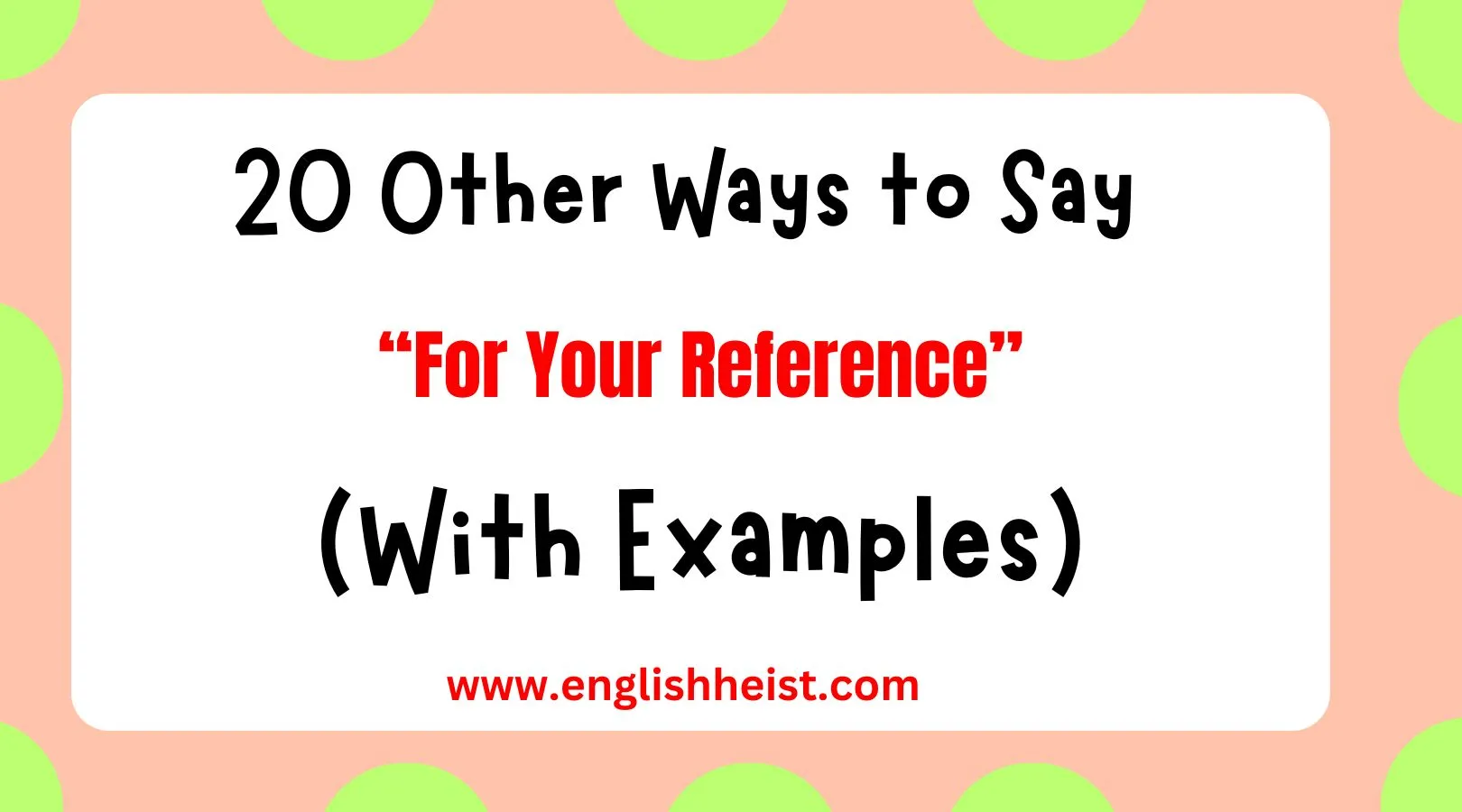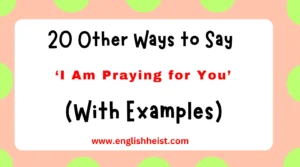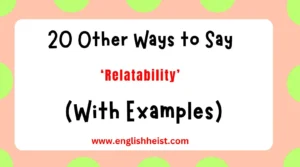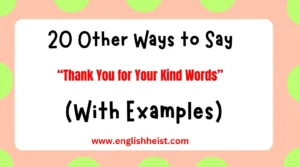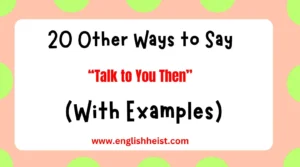In professional and casual communication, how we phrase things can make all the difference in creating a connection and making someone feel valued. Whether you’re writing an email, a report, or offering guidance, it’s essential to express yourself in ways that feel warm, considerate, and personal.
“For your reference” is commonly used in emails or messages to direct attention to additional information, but there are many other thoughtful alternatives that can convey the same idea.
This article will explore 20 other ways to say “For your reference” with explanations, best use cases, and examples to help you communicate with care and professionalism.
What Does “For Your Reference” Mean?
“For your reference” is a phrase commonly used to provide additional information to someone, typically to offer them something useful that they may need to consult.
It’s a way of guiding someone to a resource, document, or piece of information that might help clarify a situation or provide more context. While useful, this phrase can sometimes feel a little dry or impersonal.
Is It Professional/Polite to Say “For Your Reference”?
Yes, “For your reference” is both professional and polite when used appropriately in contexts where you are providing someone with information for their convenience. However, it can come across as somewhat formal or standard.
Using alternative phrases with warmth and care can soften the tone and improve the emotional impact of your communication, making it feel more thoughtful.
Pros and Cons of Saying “For Your Reference”
Pros:
- It’s straightforward and clear.
- It communicates exactly what you mean.
- It’s often used in formal or business communication.
Cons:
- It can be perceived as impersonal.
- Overusing it may come across as robotic or too technical.
- It lacks a personal touch or connection.
Main Points:
- “For your reference” is commonly used in professional settings.
- It can be formal and dry.
- Alternatives can be warmer and more personal.
Synonyms For For Your Reference
- Just so you know
- For your convenience
- As a reference
- For your information
- Attached is the [document/resource]
- For your review
- I thought you might find this helpful
- Feel free to refer to
- In case you need it
- I’m sharing this with you for your benefit
- For your perusal
- Here’s something that might help
- For your records
- I wanted to share this with you
- I’ve included this for you
- I thought you might like this
- For your insight
- This might be useful for you
- Please find [attached/below]
- I hope this helps
1. “Just so you know”
Scenario: You’re providing someone with additional information that they might find useful, but you want to keep it light and friendly.
Examples:
- “Just so you know, the meeting has been rescheduled for 2 PM.”
- “Just so you know, I’ve updated the document with the latest data.”
- “Just so you know, there are additional resources in the shared folder.”
Best Use: Informal emails, casual business communication.
Tone: Warm, casual, and approachable.
Explanation: This alternative softens the tone and makes the message feel more like a conversation. It’s friendly and not too formal, making it ideal for less rigid communication.
2. “For your convenience”
Scenario: You want to offer someone extra information to make their task easier without sounding too formal.
Examples:
- “For your convenience, I’ve attached the file you requested.”
- “For your convenience, the link to the report is here.”
- “For your convenience, please see the updated schedule below.”
Best Use: Client or customer communications, helpful suggestions.
Tone: Professional, considerate.
Explanation: This phrase conveys a sense of service and helpfulness, making the recipient feel that the information is being provided for their ease.
3. “As a reference”
Scenario: You want to remind someone that the information you’re providing can be helpful for their future use.
Examples:
- “As a reference, I’ve included the report on last quarter’s performance.”
- “As a reference, here’s the contact information for your next meeting.”
- “As a reference, attached is the policy update.”
Best Use: Formal documents, emails with resources.
Tone: Neutral, professional.
Explanation: This phrase is straightforward and conveys that the recipient can consult the information as needed, though it’s a bit more formal compared to the previous alternatives.
4. “For your information”
Scenario: You’re passing along information without expecting an immediate response, simply to keep someone in the loop.
Examples:
- “For your information, the deadline has been extended to next Friday.”
- “For your information, we will be hosting a workshop next month.”
- “For your information, the budget has been approved.”
Best Use: Formal and business emails, notifications.
Tone: Polite, informative.
Explanation: “For your information” is a professional and clear way to share useful details with someone, but it doesn’t come across as overly formal or distant.
5. “Attached is the [document/resource]”
Scenario: When you’re sending someone a file and want to make them aware of it.
Examples:
- “Attached is the meeting agenda for tomorrow.”
- “Attached is the report on last month’s sales.”
- “Attached is the updated schedule for your review.”
Best Use: Email communication, document-sharing situations.
Tone: Professional, concise.
Explanation: This phrase directly informs the recipient about the attachment, keeping the tone straightforward while maintaining a level of professionalism.
6. “For your review”
Scenario: You’re sharing something with the intention of having the recipient review or assess it.
Examples:
- “For your review, I’ve included the draft of the proposal.”
- “For your review, here is the quarterly report.”
- “For your review, please see the attached presentation.”
Best Use: When sharing documents for feedback or input.
Tone: Professional, inviting.
Explanation: This phrase is often used in professional settings when you want the recipient to examine a document or piece of work and possibly offer suggestions or approval.
7. “I thought you might find this helpful”
Scenario: When you’re sharing something that you think will be valuable to someone.
Examples:
- “I thought you might find this helpful for your upcoming project.”
- “I thought you might find this helpful—it’s a detailed report on last year’s performance.”
- “I thought you might find this helpful, as it contains the most recent guidelines.”
Best Use: Casual, warm communication with colleagues or clients.
Tone: Friendly, thoughtful.
Explanation: This alternative conveys care and attention, letting the recipient know that you’ve considered their needs while sharing useful information.
8. “Feel free to refer to”
Scenario: You’re offering a resource for someone to use at their convenience.
Examples:
- “Feel free to refer to the attached documents whenever needed.”
- “Feel free to refer to the guide I shared last week.”
- “Feel free to refer to the FAQ section for further details.”
Best Use: Offering resources that someone may need later.
Tone: Encouraging, supportive.
Explanation: This phrase is polite and suggests that the recipient can consult the provided information as needed, without pressure or urgency.
9. “In case you need it”
Scenario: You’re sharing information just in case it becomes useful later on.
Examples:
- “In case you need it, here’s the contact information for our IT support.”
- “In case you need it, I’ve attached the updated project timeline.”
- “In case you need it, here’s the link to the online database.”
Best Use: When providing additional resources or backup information.
Tone: Thoughtful, proactive.
Explanation: This alternative expresses a sense of care and foresight, ensuring the recipient knows that you’ve provided something just in case it becomes relevant later.
10. “I’m sharing this with you for your benefit”
Scenario: You want to explain that the information you’re sharing is for the recipient’s advantage.
Examples:
- “I’m sharing this with you for your benefit as it contains useful tips for your role.”
- “I’m sharing this with you for your benefit; it highlights key insights from the meeting.”
- “I’m sharing this with you for your benefit, as it may help you with the upcoming deadline.”
Best Use: When you want to emphasize that the information is intended to be helpful.
Tone: Supportive, thoughtful.
Explanation: This alternative shows genuine care and concern for the recipient’s needs, emphasizing that the information is provided with their success or ease in mind.
11. “For your perusal”
Scenario: You’re sharing a document or report that someone may need to read or review at their convenience.
Examples:
- “For your perusal, I’ve attached the updated contract.”
- “For your perusal, here is the financial summary from last quarter.”
- “For your perusal, the meeting notes are included below.”
Best Use: Formal business communication, official document sharing.
Tone: Professional, slightly formal.
Explanation: This phrase adds a sense of professionalism and is best suited for formal reports or documents that require review.
12. “Here’s something that might help”
Scenario: You’re offering useful information that could assist the recipient in a task or decision.
Examples:
- “Here’s something that might help—our latest market research findings.”
- “Here’s something that might help: a guide on how to use the new software.”
- “Here’s something that might help with your project—feedback from last year’s clients.”
Best Use: When providing helpful guidance or support.
Tone: Warm, supportive.
Explanation: This phrase makes the communication feel more personal and caring, showing that you are proactively offering value.
13. “For your records”
Scenario: You’re providing a document or important information that the recipient might need to keep.
Examples:
- “For your records, I’ve attached a copy of your signed agreement.”
- “For your records, here’s the invoice for this month’s services.”
- “For your records, you’ll find a summary of today’s discussion attached.”
Best Use: When sending documents or important details for future reference.
Tone: Professional, neutral.
Explanation: This phrase is often used in official communications where documents or important information need to be retained.
14. “I wanted to share this with you”
Scenario: You’re providing helpful or relevant information in a warm and engaging way.
Examples:
- “I wanted to share this with you—the latest insights from our industry report.”
- “I wanted to share this with you in case you find it useful for your presentation.”
- “I wanted to share this with you because it aligns with our recent discussion.”
Best Use: When making a message feel more personal and intentional.
Tone: Friendly, considerate.
Explanation: This alternative conveys warmth and thoughtfulness, making it ideal for communication where personal connection matters.
15. “I’ve included this for you”
Scenario: You’re adding information to an email or message to be helpful.
Examples:
- “I’ve included this for you—a checklist to help with your onboarding process.”
- “I’ve included this for you in case you need more context on the project.”
- “I’ve included this for you to review before our next meeting.”
Best Use: When providing an additional resource for the recipient.
Tone: Thoughtful, slightly informal.
Explanation: This phrase emphasizes that the information is included as a gesture of care or support, making it feel more personal.
16. “I thought you might like this”
Scenario: You’re sharing something that might be of interest or benefit to the recipient.
Examples:
- “I thought you might like this—an article about leadership strategies.”
- “I thought you might like this new report on customer trends.”
- “I thought you might like this template for your next project.”
Best Use: When sharing optional but useful information.
Tone: Friendly, engaging.
Explanation: This phrase makes the message feel warm and inviting, showing genuine interest in the recipient’s needs.
17. “For your insight”
Scenario: You’re providing information that you’d like the recipient to consider or reflect on.
Examples:
- “For your insight, here’s a breakdown of the survey results.”
- “For your insight, I’m attaching the competitor analysis report.”
- “For your insight, you’ll find the latest market research findings enclosed.”
Best Use: When asking someone to consider information thoughtfully.
Tone: Professional, respectful.
Explanation: This phrase invites the recipient to engage with the material in a meaningful way rather than just acknowledging it.
18. “This might be useful for you”
Scenario: You’re offering helpful information in a considerate manner.
Examples:
- “This might be useful for you—a quick summary of our discussion.”
- “This might be useful for you in planning your next steps.”
- “This might be useful for you as you work on the proposal.”
Best Use: When offering potentially helpful information without assuming it’s needed.
Tone: Thoughtful, supportive.
Explanation: This phrase keeps things open-ended, making it feel like a genuine offer rather than a directive.
19. “Please find [attached/below]”
Scenario: You’re directing someone’s attention to a document or resource in a professional manner.
Examples:
- “Please find attached the latest financial report.”
- “Please find below the list of action items from the meeting.”
- “Please find attached the updated contract for your review.”
Best Use: Business and professional settings, especially for formal document sharing.
Tone: Polite, formal.
Explanation: This phrase is widely used in professional emails and ensures clarity when sharing documents or relevant details.
20. “I hope this helps”
Scenario: You’re providing information in a kind and supportive way, emphasizing your willingness to assist.
Examples:
- “I hope this helps with your presentation preparations.”
- “I hope this helps clarify any questions you had about the project.”
- “I hope this helps—please let me know if you need anything else.”
Best Use: When you want to offer assistance and make the message feel warm and personal.
Tone: Encouraging, kind.
Explanation: This phrase adds a personal touch, making it clear that you genuinely care about the recipient’s needs.
Conclusion
Choosing the right words in your communication can make a significant difference in how your message is received. While “For your reference” is a commonly used phrase, incorporating warmer, more thoughtful alternatives can create a stronger connection with your audience. Whether you need to sound professional, supportive, or conversational, there’s a perfect phrase to match your intent.
By using these alternatives, you can ensure that your emails and messages feel more engaging, helpful, and considerate. The right words not only convey information but also show thoughtfulness and care.

Mia Rose is your go-to platform for mastering the English language. Through clear, concise lessons and expert advice, Mia makes learning grammar, vocabulary, and writing skills easy and enjoyable. Whether you’re a beginner or looking to refine your skills, English Heist helps you communicate confidently and effectively.
